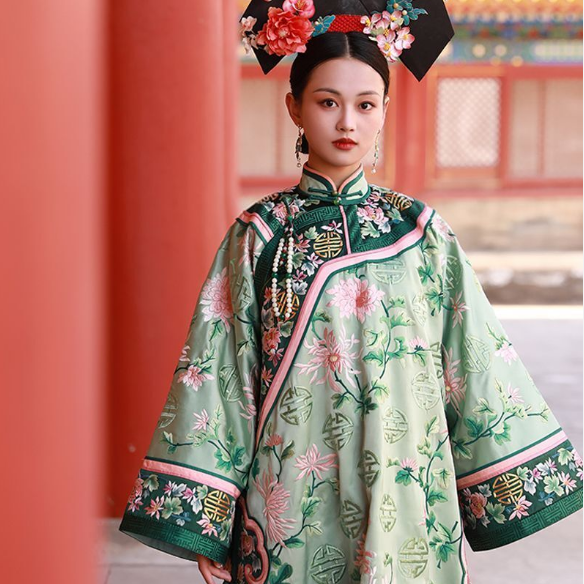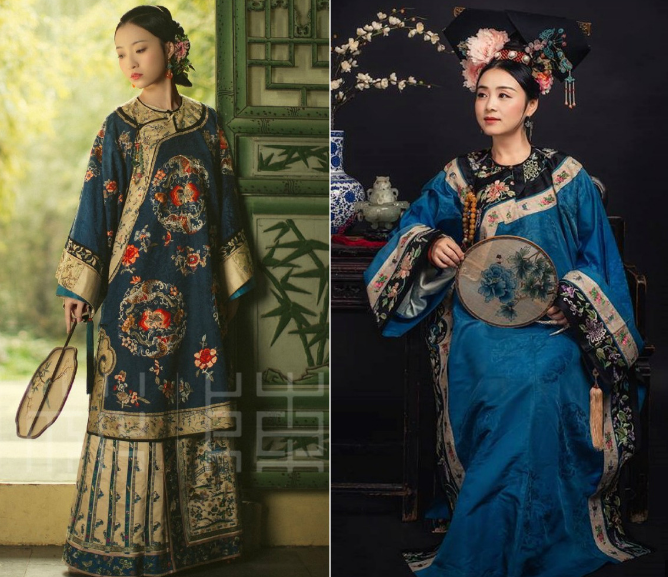The Qing Dynasty Hanfu mirrored cultural shifts through Manchu-style adaptations and symbolizing socio-political dynamics.
Historical Context of Qing Dynasty Hanfu
Overview of Qing Dynasty Era
The Qing Dynasty, a pivotal era in Chinese history, spanned from 1644 to 1912, marking the last imperial dynasty of China. This period, known for its significant political, social, and cultural shifts, was initially established by the Manchu people who overthrew the Ming Dynasty. The Qing era is often characterized by its expansionist policies, which led to the largest territorial reach in China’s history. Intriguingly, the Qing rulers maintained a distinct Manchu identity, while simultaneously adopting and adapting traditional Han Chinese culture to reinforce their legitimacy.
One of the most notable aspects of this era was the strict imposition of Manchu dress codes across the empire, which profoundly influenced the Hanfu, the traditional clothing of the Han Chinese. These regulations were not merely superficial changes in fashion but symbolized the deeper political and cultural integration (or, in some views, assimilation) under Manchu rule.

Hanfu in Earlier Dynasties
Hanfu, before the Qing Dynasty, underwent several transformations, reflecting the ethos of each period. To understand the profound changes during the Qing era, it’s crucial to contrast Hanfu’s evolution in earlier dynasties:
| Dynasty | Fabric and Material | Style and Cut | Symbolism and Color | Notable Features |
|---|---|---|---|---|
| Tang Dynasty | Silk, linen | Loose, flowing robes | Bright, varied colors | Emphasis on luxurious display |
| Song Dynasty | Cotton, lighter silk | Simplified, modest | Subdued colors | Practicality and modesty |
| Ming Dynasty | Fine silk, brocade | Elaborate, layered | Vibrant colors, intricate patterns | Resurgence of traditional Han culture |
This table highlights the dynamic nature of Hanfu, influenced by each dynasty’s socio-cultural landscape. The Tang Dynasty, known for its cosmopolitanism and opulence, saw Hanfu that was luxurious and colorful. The Song era introduced more practical and modest attire, reflecting the Confucian ethos of restraint. The Ming Dynasty, with its revival of Han nationalism, brought back intricate designs and vibrant colors, celebrating traditional Han identity.
The Manchu Influence on Hanfu
With the advent of the Qing Dynasty, Hanfu experienced significant modifications due to the Manchu influence. The Manchu, with their distinct cultural and sartorial identity, imposed dress codes that mandated the wearing of Manchu-style clothing, especially for those in official positions or attending court. This edict marked a significant departure from the traditional Hanfu styles.
The Manchu-style garments, known as the “Qipao” or “Cheongsam” for women and “Changshan” for men, featured a straight cut, high collars, and narrow sleeves. These designs were starkly different from the flowing robes of previous Hanfu styles. The Manchu influence extended to hairstyle as well, with the introduction of the queue hairstyle for men, signifying submission to the Qing rule.
This era of sartorial change was not only about clothing but also represented a deeper cultural shift. The Manchu rulers, while imposing their own styles, also adapted and incorporated elements of Han culture. This complex interplay of cultural exchange and dominance reflected the broader socio-political dynamics of the Qing Dynasty.
The Qing Dynasty’s Hanfu vividly illustrates the intricate tapestry of cultural change, where clothing was not just a matter of fashion but a potent symbol of identity, power, and resistance. The transition from the traditional Hanfu to the Manchu-influenced styles provides a fascinating lens through which to view the broader historical and cultural transformations of this era.
Cultural Shifts Reflected in Hanfu Styles
Adaptation to Manchu-Qing Dress Codes
The Qing Dynasty ushered in a significant transformation in Hanfu styles, primarily due to the adaptation to Manchu-Qing dress codes. This change reflected the political dominance of the Manchu rulers. Traditionally, Hanfu featured wide sleeves and a flowing silhouette, but during the Qing era, it evolved into a style more aligned with the straighter, structured Manchu fashion. For women, the Qipao or Cheongsam, known for its straight cut and body-fitting silhouette, replaced the traditional Hanfu robe. This adaptation symbolized the Qing Dynasty’s influence over the Han people, illustrating a political narrative through fashion. Similarly, men’s fashion shifted to the Changshan, a long robe with a straight cut, contrasting the previously popular cross-collared robe. The queue hairstyle, mandated for men, became a potent symbol of submission to the Qing rule.
Integration of Ethnic and Regional Variations
The Qing Dynasty’s vast territory and diverse population led to the integration of various ethnic and regional styles into Hanfu. This period marked an era where Hanfu transcended a singular style and became a representation of the empire’s diverse cultural landscape. For example, in regions like Mongolia and Tibet, local styles with unique elements like fur trims and specific embroidery patterns began influencing Hanfu designs. Such integration reflected the Qing Dynasty’s approach to cultural inclusion, showcasing an effort to unify a vast and diverse empire under a single rule. The use of local materials and techniques in Hanfu designs also varied significantly. While silk remained predominant in regions rich in this fabric, cotton and wool saw increased use in other areas, showcasing the empire’s rich diversity in resources and cultural practices.
Symbolism in Hanfu Designs and Colors
During the Qing Dynasty, symbolism in Hanfu designs and colors played a crucial and meaningful role. The use of specific colors and motifs carried deep cultural and symbolic meanings. The imperial use of yellow, traditionally reserved for the emperor, and dragon motifs, representing strength and fortune, are prime examples of this practice. These symbols were not mere decorations but reflections of the prevailing Confucian values and philosophical beliefs. In the everyday attire of the common people, floral patterns symbolized nature and harmony, while colors like blue and green were associated with tranquility and renewal. Hanfu’s symbolism extended to specific occasions; for instance, red, symbolizing luck and happiness, was the dominant color in traditional weddings. These practices highlighted the cultural significance of Hanfu, making it a vital part of Qing society’s fabric and a reflection of its diverse cultural and philosophical landscape.
Social and Political Influences on Hanfu Evolution
Imperial Regulations and Their Impact
The evolution of Hanfu during the Qing Dynasty was significantly driven by imperial regulations and their impact. The Qing government, led by the Manchu rulers, established stringent dress codes as a means of consolidating their rule over the Han majority. Notably, these regulations mandated the adoption of Manchu clothing styles, a shift that signified political allegiance to the new rulers. The impact of these regulations was profound:
- Enforcement of the Queue Order: One of the most symbolic changes was the enforcement of the queue hairstyle for men, which required Han men to shave the front of their heads and grow a queue in the back. This hairstyle, deeply alien to Han traditions, was a clear indication of the Qing’s control over personal and cultural expressions.
- Introduction of Manchu-style Clothing: The traditional Han robes, characterized by their cross-collar and wide sleeves, gave way to Manchu-style clothing. This included garments like the Cheongsam for women and the Changshan for men, both of which featured a straighter cut and a more rigid silhouette.
These changes were not merely aesthetic but symbolized the Qing’s dominance over the Han, intertwining fashion with politics in a way that was unprecedented in Chinese history.
Hanfu as a Marker of Social Status and Identity
Hanfu, beyond its functional and aesthetic appeal, served as a marker of social status and identity. During the Qing Dynasty, one’s attire was a direct reflection of their social position:
- Clothing as an Indicator of Social Hierarchy: Different classes wore distinct styles of Hanfu, which indicated their position in the social hierarchy. For example, the quality of silk, the intricacy of embroidery, and the use of specific colors were reserved for the nobility and the wealthy.
- Ethnic Identity and Hanfu: For the Han people, Hanfu became a symbol of their ethnic identity, especially in the context of the Manchu rule. Adhering to traditional Han styles became a subtle form of expressing cultural pride and resistance.
This aspect of Hanfu illustrates how clothing can be a powerful tool in social differentiation and cultural identity preservation, especially in a multi-ethnic empire like the Qing Dynasty.
Resistance and Preservation of Han Culture through Dress
The Qing era also witnessed resistance and preservation of Han culture through dress. Despite the Manchu-imposed regulations, many Han Chinese found ways to preserve their traditional clothing styles:
- Subtle Adaptations of Hanfu: While outwardly conforming to Manchu styles, many Han Chinese incorporated elements of traditional Hanfu into their clothing. This included hidden layers of Han robes under Manchu garments or the use of traditional Han patterns and colors in a Manchu-style outfit.
- Cultural Preservation through Hanfu: Hanfu became a symbol of cultural resistance and preservation for the Han people. Celebrations, weddings, and festivals often saw a resurgence of traditional Hanfu, as these were occasions where cultural expression was more freely exercised.
Through these acts of resistance and preservation, Hanfu remained a vital part of the Han Chinese identity, silently defying the cultural dominance of the Qing rulers and keeping the rich tapestry of Han culture alive.

Hanfu Reflection of Changing Gender Norms and Aesthetics
Gender Differentiation in Hanfu Styles
The Qing Dynasty’s Hanfu styles prominently displayed gender differentiation, a reflection of the era’s social norms and values. For men, the Hanfu evolved into more structured and straight-lined garments, such as the Changshan, which was a long robe with a straight cut, symbolizing masculinity and formality. In contrast, women’s Hanfu, notably the Qipao or Cheongsam, became more form-fitting and accentuated the female form, showcasing a shift in how femininity was perceived and presented. This period marked a significant departure from earlier dynasties, where men’s and women’s clothing shared more similarities in form and style.
- Men’s Hanfu: Emphasized a more upright and rigid silhouette, mirroring the societal expectations of male authority and stoicism.
- Women’s Hanfu: Transitioned to accentuate body lines, reflecting a shift in the societal view of femininity, from a focus on modesty to one that also embraced and celebrated the female form.
The Aesthetics of Elegance and Modesty
During the Qing Dynasty, Hanfu embodied the aesthetics of elegance and modesty, two crucial values deeply rooted in Confucian culture. This period saw Hanfu designs that balanced ornateness with simplicity, demonstrating the cultural emphasis on modesty while not compromising on aesthetic beauty.
- Ornamentation vs. Simplicity: Hanfu designs incorporated intricate embroidery and fine fabrics, yet the overall silhouette remained modest and understated. This balance illustrated the cultural ethos of valuing beauty but not at the expense of modesty.
- Colors and Fabrics: The choice of colors and fabrics also reflected these aesthetics. While vibrant colors were used, they were often balanced with softer, muted tones. Silk remained a popular fabric, symbolizing elegance, but was often used in a way that upheld the value of modesty.
Hanfu Role in Modern Cultural Renaissance
Hanfu has recently experienced a renaissance, playing a significant role in modern cultural identity and expression. In contemporary China and among the global Chinese diaspora, there is a growing interest in traditional Hanfu, driven by a desire to reconnect with cultural heritage.
- Cultural Revival and Identity: The modern Hanfu movement sees individuals embracing traditional attire as a means of expressing cultural pride and reconnecting with historical roots.
- Influence on Modern Fashion: This renewed interest in Hanfu has also influenced modern fashion, with designers incorporating traditional elements into contemporary clothing, thus creating a fusion that resonates with younger generations.
Through these developments, Hanfu transcends its historical context, becoming a symbol of cultural continuity and a living representation of China’s rich heritage in an ever-globalizing world.